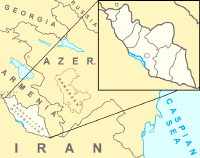LONDON, (CAIS) -- The joint archaeological expedition team from United States and the Republic of Azerbaijan, in the autonomous republic of Nakhjavan (nowadays Nakhchivan), has yielded to new findings date back to the first Iranian dynastic Empire, the Medes (728-550 BCE).
The ceramic samples were also found during the archeological digs in the ancient settlement today known as Oglangala in the Sharur region of the Nakhjavan.
'The digs held in Oglangala fortress city revealed the residuals of ancient buildings, including a large palace, date to the Median dynasty of Iran. Also the expedition team have discovered ancient graves, a number of other samples of material culture', said Veli Bakhshaliyev, a leading member of the expedition team, organised by the Institute of History, Archaeology and Ethnography of the Nakhchivan Department of the National Academy of Science of Azerbaijan in cooperation with the archaeologists of the Pennsylvania University.
The discovered ceramics dated the 2nd-early 1st millennium BCE, the academician said. According to him, the previous researches of the expedition revealed that Oglangala, which is a modern name of the area was the center of an ancient state and it was subjected to attacks of ancient Urartu kingdom.
'We wondered how such a strong state as Urartu failed to occupy the city. Based on the result of the digs, it can be said for sure that this region was a center of a semi-independent ancient state which was fighting with Urartu.
The Ancients residing in this territory have created a rich culture, constructed a grandeur palace with big columns, said another head of the expedition, professor of the Pennsylvania University Lauren Ristvit.
She said the joint US-Azerbaijani archaeological expedition has been holding studies in Sharur region since 2008 and intends to continue studies next year.
In 2009 the expedition team has also discovered a number of cuneiform inscriptions, without revealing their language. The territory after the collapse of Median dynasty in 550 BCE, became part of the Achaemenid dynasty (550-330 BCE) and therefore, the language of the discovered inscriptions could be Old-Persian.
The report by the joint US-Azerbaijani expedition team, neither have mentioned the Medians were Iranian, nor stated this territory was part of Iran since the ancient times until 1828.
The name Nakhjavan, possibly derived from the middle-Persian compound of 'nakhchir+wan' ('tree quarry', i.e. tree supplying ground), while some believe the name derived from Armenian meaning 'the place of descent', a Biblical reference to the descent of mythical Noah's Ark on the adjacent Mount Ararat. The medieval geographers however referred to the area as Nashava.
Nakhjavan and nowadays the Republic of Azerbaijan, were parts of the Iranian province of Arran until 1828. The name of the former province was changed to the Republic of Azerbaijan in 1918.

